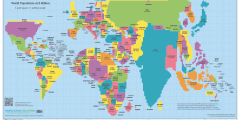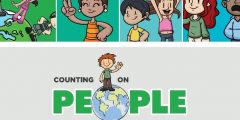What is Population Education?
Population Education is all about people – how many of us there are, how we shape the world around us, and how we interact with each other. Our human population has grown from 1 billion to over 7 billion in just over 200 years, and we’re still growing. It is predicted that by 2050, there will be another 2 billion people on our planet.
Population Education strives to help students understand just what this growth means. Our K-12 materials encourage students to think critically about how people interact with each other and the world around them – how we use our natural resources, how each of us impacts environmental quality, and how we can work to ensure human well-being at home and around the globe.
Population Education materials encourage students of all grade levels to think critically, engage in real world issues, and work to become the next generation of informed leaders, voters, and global citizens.
Population Education Materials
What resources does Population Education offer to help me teach population in my classroom?
We offer a wide range of options to support your teaching of population issues:
- Activity Lesson Plans: Our activities feature student-centered, hands-on learning and can be used to supplement instruction or can be combined to form full units. Search our Classroom Resources module to get started!
- Products: We have a variety of teaching kits ranging from grades K-2 to 9th-12th grade. We also offer supplemental products and resources including our award-winning “dot” video, World Population and our 2-sided Quick Trip to 7 Billion poster. Visit our Store to learn more about what we offer.
- Teacher Training Workshops: We conduct hands-on training workshops for teachers and future teachers. Look for us at a teacher conference near you or invite us to lead an in-service program for your school or district. Our sessions consistently receive outstanding ratings from participants! Learn more about our workshops on our Teacher Workshops page.
What grade levels can I teach using Population Education materials?
We have materials for grades K-12. Visit our Classroom Resources module to browse lesson plans and curriculum items by grade level and/or subject area.
What issues do Population Education materials address?
That depends on the grade level focus:
- Early childhood and elementary students learn how they are connected with their communities and the natural world. Topics include the importance of wildlife and healthy ecosystems, resource use and waste production, basics of trade and immigration, communities, cooperation, and service learning.
- Secondary level issues include food and water security, public health, climate change, resource use and sustainability, biodiversity, global wealth distribution, women’s status, and more.
Are Population Education materials and resources relevant to international teachers?
Many Population Education lessons, readings, products, and tools take a global view of population and related issues. As such, our materials can easily be integrated into classrooms outside of the United States. And many international teachers are already using PopEd resources, as evidenced by the significant portion of current lesson plan downloads from non- U.S. locations. Wherever educators are looking for content that is hands-on, current, and based in real-world data, PopEd lessons are sure to be of value.
For example, Population Education lessons are a wonderful fit for several required upper primary and secondary courses in India – Environmental Studies Classes (III-V), Geography Classes (VI-XII), and Science Classes (VI-XII). Visit our Standards page to find matches between PopEd lesson plans and specific Indian standards.
You can also find Population Education materials in other languages. The World Population video, our stunning six-minute film of world population history, has audio tracks in Spanish, French, Mandarin, Hindi, and Arabic, as well as English.
“Our World, Our Future,” or “Nuestro Mundo, Nuestro Futuro,” are Spanish/English activity guides. There is a packet for elementary classrooms and a packet for secondary classrooms, each including a teacher’s guide, student background reading, 6 – 8 lesson plans, and a glossary. All of these items are provided in both Spanish and English to offer teachers and students maximum flexibility.
Are you associated with the World of 8 Billion student video contest?
Not only are we associated with the contest, but we run it! The World of 8 Billion student video contest is a project of the Population Education program and it first ran during the 2010-2011 school year as a “teachable moment” based around world population reaching 8 billion. The contest is open to students from any country around the globe and is often used by teachers as an assigned classroom project.
Importance of Population Education
How does Population Education fit in with what I teach?
Population Education materials are correlated to national, state level and Common Core standards and compliment instruction in math, science, social studies, language arts, geography, economics, and environmental studies, as well as Advanced Placement (AP) and International Baccalaureate (IB) courses.
We pride ourselves on creating lessons that have real-world relevance and challenge students to develop 21st century learning skills — problem solving, critical thinking, collaboration, and communication. Teaching students to be globally aware and environmentally literate not only helps teach content standards, but also prepares students to become successful leaders in tomorrow’s world.
Why should I teach about population?
- It’s important: Population growth is central to many of the environmental and social issues we face today. Educating students on the impacts of our human numbers and lifestyles, helps to ensure that we leave a sustainable human footprint for generations to come.
- It’s relevant and cross-curricular: Teaching about population is a natural way to tie real-world content across the curriculum. Population is ecology, human geography, economics, public health, history, and civics all rolled into one, with a good bit of math to help us understand past, current, and future trends.






